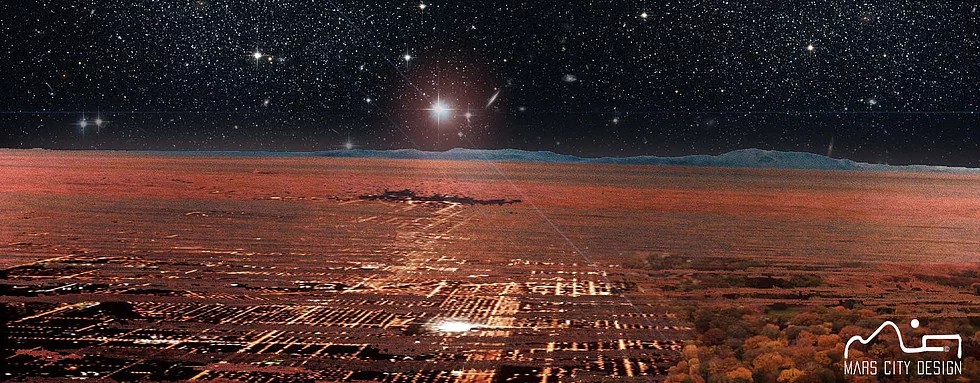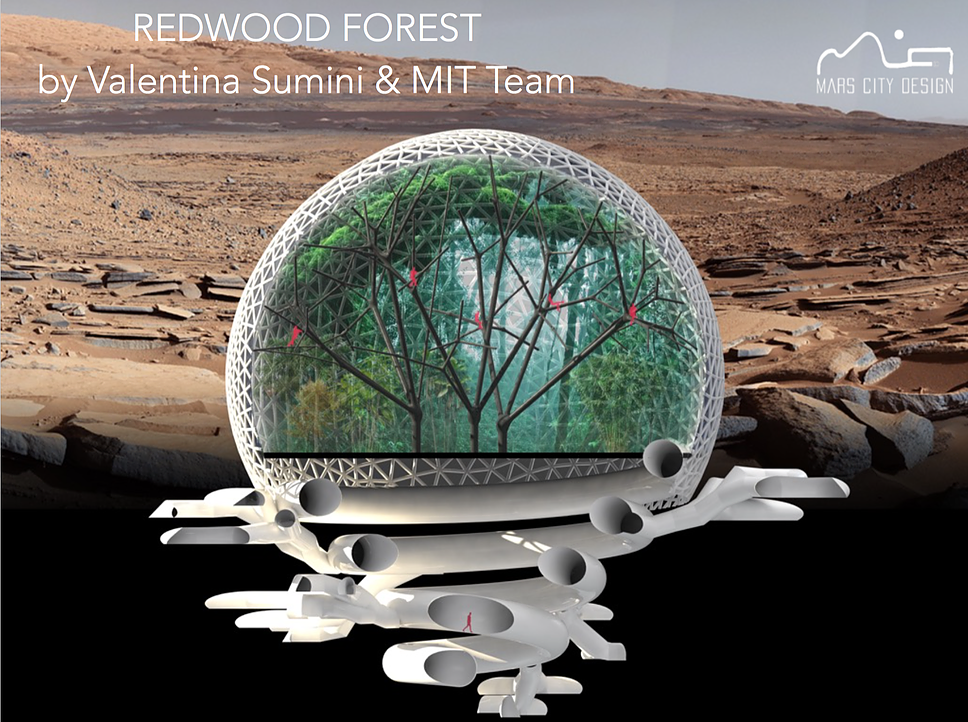 Martian City, 2100+ year
Martian City, 2100+ yearThe jury of
Mars City Design 2017 summed up the results of the competition of projects of cities on Mars. This year, the winners were chosen in five categories: architecture, urban design, transportation, AI, sustainable energy sources. Like other similar contests, participants here must solve the problem of building livable buildings from local materials, when the very minimum is brought from Earth.
The contest organizers from the Mars City Foundation sincerely believe that someday people will be able to populate the surface of the Red Planet. Moreover, they are in favor of the fact that preparations for colonization must begin now. Given the planned missions, more information about Mars should be included in the school curriculum, because the current students will be among the first settlers in the Martian cities. And indeed, such a calculation is consistent with the plans of Ilona Mask, and with the plans of the international community -
NASA, ESA and partners . It is not surprising that these two agencies sponsored the competition.
NASA
is planning to develop the Deep Space Transport (DST) spacecraft for flights in deep space, including Mars. It will be a reusable electric and chemical craft. The ship will take people from the lunar spaceport, take them to Mars or to another destination - and then return back to the Moon. Here the ship can be repaired, filled - and sent to the next flight. In the late 2020s, NASA plans to conduct a one-year test of Deep Space Transport with the crew, so the current generation of students will still be youngsters when NASA begins preparing for a manned mission to Mars.
The Mars City Design 2017 competition in the Architecture category was won by the
Redwood Forest project, prepared by an interdisciplinary group of students and postdoctoral students at the Massachusetts Institute of Technology (MIT).
 Project Redwood Forest from MIT
Project Redwood Forest from MITRedwood Forest is a collection of forest groves within spheres that are connected to each other by a system of tunnels called “roots.” Roots allow you to travel safely between spheres and give people the opportunity to retire in their personal corners, as stated in the MIT documentation. The tunnels also provide protection against cosmic radiation, micrometeorites and extreme temperature extremes.
Each of the spheres with roots will become a place of life for 50 people. The project authors propose to build about 200 spheres to house a colony of 10,000 settlers.

“On Mars, our city will physically and functionally repeat the forest using local Martian resources such as ice and water, regolith (soil) and the sun to sustain life,” said postdoctoral student Valentina Sumini from the Martian architecture group. “Forest cultivation also symbolizes the potential for external growth as nature spreads throughout the Martian landscape.”
The surface of the spheres will be covered with soft transparent cells with water protecting the settlers from cosmic radiation from the roots into the forest. This surface also softens temperature variations and provides water for fish and farms. With the help of solar panels, electricity is generated and water is electrolyzed to collect hydrogen, which is used in fuel cells and rocket fuel.
The Mars City Design competition was held for the second time - and the registration for the next year, the
Mars City Design 2018 competition, is already open. Applications are accepted in four categories. A specific time period has already been established for which the design should be created: the
2043rd year . Conditions in advance include the foundation of urban construction, taking into account currently known scientific data on the most optimal location of the base.
Categories Mars City Design 2018
- Architecture and urban design . The center of the Mars City LAB laboratory with an area of 1 km², where soil samples are taken from all over the planet, is used to analyze and send the results to Earth via a network of orbital relay satellites. The goal - to find sources of water, oxygen and building materials for the construction of urban buildings. Location: Any point in the Mariner Valley. Above the surface, on the surface or below the surface
- Technique and transport . Aerostat for assembly of samples with a small rocket for sending samples in the vicinity of the laboratory. Aerostats provide accompanying documentation on the Martian atmosphere (wind) and the built-in navigation system by controlling the height change and selection of a tailwind, like Google Loon.
- Robotics . Rovers that work inside the Mars City LAB laboratory or outside, including a robot cleaner for cleaning the lab territory, a miner robot for extracting useful resources and a sample collector robot that detects rockets from balloons, finds samples and arrives in the laboratory .
- Other . Martian sport, health, fashion and more.